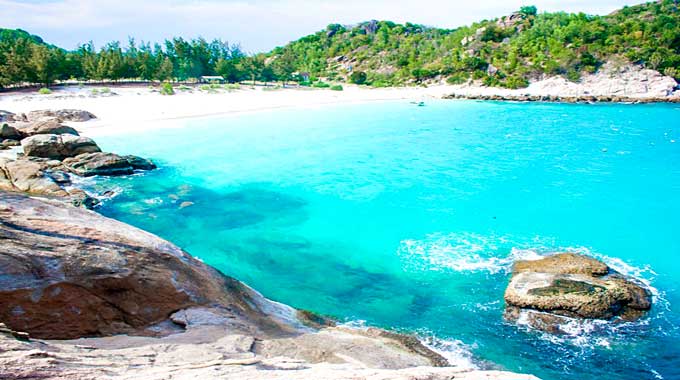An endless blue embraces a white sand bank. Big rocks shaped like rough caricatures of different animals stand sentinel on the beach. You are admiring the scenery on Binh Lap Beach.

Apart from its most popular attraction, Nha Trang, the coastal province of Khanh Hoa boasts many beaches that are still pristine, and one of them is Binh Lap, located in Cam Lap Commune, Cam Ranh District.
Binh Lap is 90km from Nha Trang and 35km from the Cam Ranh Airport. From the Ba Ngoi Wharf in Nha Trang, it used to take two hours to get to Binh Lap Village, which overlooks the sea from a comfortable height. However, in recent years, it can be accessed by motorbikes via a newly-built road that skirts around the Nui Chua Mountain. This is a good way to enjoy the unfolding landscape of the sky, sea and mountain.
Those travelling by train get off at the Thap Cham Station, 40km from Binh Lap.
Once we got there, we took a leisurely walk on the beach, breathing in the freshness of salt-smelling breezes that blew in from the sea. The transparent waters allowed us to enjoy the incessant drama of shifting sands.
Along the coast of Binh Lap Village, several "mini-beaches" - Lao, Kinh and Ngang - invited us to swim, each with a different look difficult to describe. After accepting the invitation, we take a boat to Binh Hung Island, an hour away.
There is no point not climbing to the top of the Hon Chut Lighthouse built on the island almost 100 years ago. The panoramic view of Cam Ranh Bay with the tiny-looking boats and lobster farms is something that will stay with us.
Apart from other swimming options - the Robinson, Chuoi and Ong Gia beaches - visitors can also choose to soak themselves in a freshwater stream and hire a boat with a glass bottom to see the coral reefs.
Armed with a pair of goggles and a waterproof camera, I took a short dive to get closer to the coral and make the acquaintance of many colourful fishes.
For the picky tourist, accommodation - medium-quality rooms of homestays - can prove to be a disappointment, but the tranquility and food cooked by the locals make up for it.
We decided to return to Binh Lap Village to spend the night.
Binh Lap used to be the poorest village in Cam Lap Commune, because it stood isolated between the sea and the mountain. The villagers earned their living by small-scale fishing.
In recent years, they have developed lobster breeding, and life has gotten better, according to resident Nguyen Van Chau.
"We have a better life thanks to the lobster farms and tourism," he said.
Beside fishing, he has opened a small stall to serve fresh seafood. Grilled lobster is a must-try dish. Chau leads gourmets to his lobster cages and catches the ones they select. He said villagers dry corals on beach and use them as "cradles" for breeding small lobsters.
The barbecue party on the beach ended with a camp fire. Sitting with the locals around the fire and listening to their stories was an experience to remember.
At dawn, the local fishermen allowed us to go fishing with them. They cast a net and asked us to help them draw them in. The net was heavier than it looked. That our group of seven needed to huff and puff away for a while just three of the locals did it in minutes showed us how unfit we were, relatively speaking.
The small fish we caught might not have impressed the fishermen, but for us, the experience of catching was more important than the catch.
We had set out looking for a different holiday on the beach, and Binh Lap delivered on its promise.